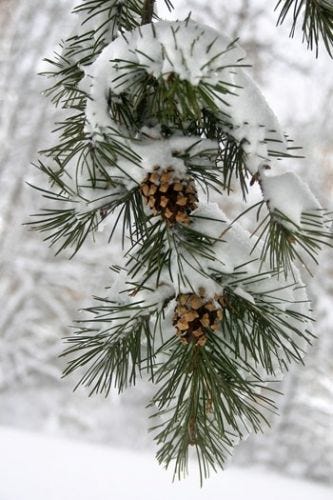Winter Garden Projects
Winter and cold weather can be a good time to do certain outdoor projects. With periodic seasonal drought being a reality for many readers, working with the seasons and the nature of your unique climate is the way to go when you want to optimize your gardening, land, and plant stewardship
The following is my list of winter garden projects - reloaded and updated from the October 2014 - Fall Gardening and Preparing for Winter post.
Yard To Lawn Upgrades - When it's wet out and your plants are dormant you can often more easily work the soil and remove lawns. From there you can make a garden and/or do mulching.
Sheet mulching with cardboard is often a good option I've seen work well depending on what plants you dug up or have in the soil you are putting it over. It adds a double layer of protection with wood chips, and is also completely biodegradable as far as I know - as long as you use it clean of food (if not the animals will dig it up to eat the scraps) remove any tape, staples, glue/waxes, or labels before you lay it down and cover with wood chips.
If you'd like your lawn removed and you’re topsoil preserved in the process, I invite you to contact me to do the job. I specialize in hand weeding and grass removal techniques that leaves your topsoil in place without the use of gas powered equipment.
Planning, Design and Assessment - Winter is a good time to walk your garden in dormancy to plan for next year, make note of what you want to maintain and improve, and consider what you want to plant or remove.
Pick Your Seeds - Great time to go through your seed catalogs to order the stuff you want to do from seed in your edible gardens!
I'm a big fan of heirloom and seed saver varieties that support organic farmers and avoid GMO's. Check out these companies!
Leaf Cleanup: to get the leaves off your lawn, and either around your freeze sensitive plants or as covering for your garden beds, into your compost, or off to the transfer station.
Leaves fall to feed the ground and there is something to be said for the fact that nature does this seasonally. So by all means, use your leaves as a soil and root covering for the winter. You can always rake them away in the spring when you want to start working your soil and and opening up breathing from the feeder roots of your plants.
Remember, we are working WITH nature to create health and beauty in your garden - this is nature's lead for the season of fall going into winter!
Pruning - With cooler weather it is safer to do pruning of your bushes and shrubs. Fruit trees and trees in general (non-evergreen) are best done in the winter after all the leaves have fallen so you can more easily see the naked structure of your tree.
Soil Amending - This means adding fresh soil to your plants and/or working soil into existing beds. Makes sure you use the right soils for the specific areas.
Good soil and compost is the MEAT of your gardens beds - a true fundamental for healthy and beautiful plants!
Plant Protection - For plants you want to protect against freezing weather - check the local weather forecast for below 32 degree temps and get mulch, straw, leaves (as mentioned above) or covers around the root zone of those plants you want to protect.
Covering your feeder root zones during winter dormancy is always fine, but during the spring, summer, and fall you want this zone uncovered with the roots of your plants exposed to the surface of the soil because this is the zone they breath from.
Gutter Cleaning - Don't forget to keep your gutters and downspouts around your home clean and flowing. Now that all the leaves have fallen, and we are in the wet season where rain is often part of the weather, now is a great time to clean your gutters and downspouts.
“When we plant a rose seed in the earth, we notice that it is small, but we do not criticize it as “rootless and stemless.” We treat it as a seed, giving it the water and nourishment required of a seed. When it first shoots up out of the earth, we don’t condemn it as immature and underdeveloped; nor do we criticize the buds for not being open when they appear. We stand in wonder at the process taking place and give the plant the care it needs at each stage of its development. The rose is a rose from the time it is a seed to the time it dies. Within it, at all times, it contains its whole potential. It seems to be constantly in the process of change; yet at each state, at each moment, it is perfectly all right as it is.”
-Timothy Gallwey
Straight Up & Free with James D is a reader supported publication.
If you found this valuable and educational, and appreciate the craftsmanship and care I bring in providing this content, please consider upgrading your subscription to support my work. You can also give a gift subscription, or make a one time donation.
Thank you!



